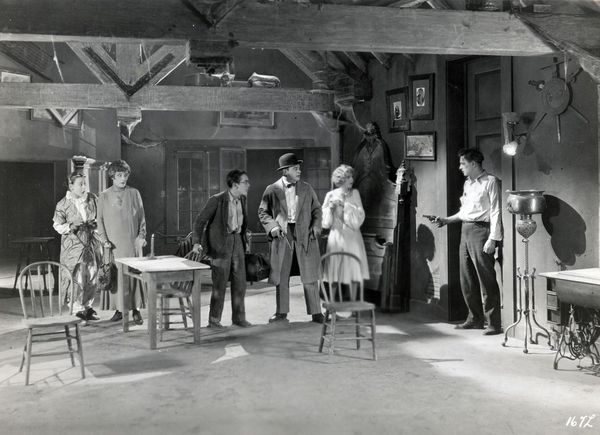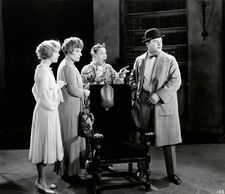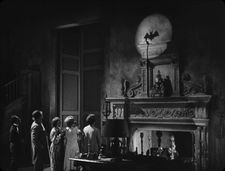 |
| The Bat Photo: courtesy of MOMA |
In 1926, Roland West’s silent horror comedy The Bat wowed cinema audiences with its story of criminal daring and double-crosses set in a mysterious mansion. Today, it gets attention for another reason; as a clear precursor to the story of Batman. Long thought to be lost, it has recently been restored and brought back to the big screen by Undercrank Productions. I recently spoke with producer Ben Model, a musician who has provided live accompaniment for numerous such films in cinemas, who told me the story of The Bat and of his ongoing work in recovering the lost treasures of the silent era.
"The Bat was pretty much missing for decades,” he begins. “A nitrate print turned up in Boise, Idaho in the late 1980s. And a professor at Boise State named Tom Trusky, and Frank Thompson – a well-known film historian and author – ensured that the nitrate made its way to the UCLA Film and Television Archive, who then photochemically preserved and restored it. And then, like many films that get preserved or restored by an archive, it played a few festivals for a year or two, it went back in the vaults and for reasons nobody really knows, programmers never picked up on it.
“Anybody who can show 35 millimeter film has had the ability to programme and screen it for an audience since the early 1990s, but they haven't. So that's the other part of it being lost – it was just forgotten. When we started our home video project, I asked one of the two film curators at the UCLA Film and Television Archive we were working with, ‘How many times has the has the 35mm print been booked since your photochemical restoration was done?’ He looked it up. He said ‘12 times, and two of those were overseas.’ And I happen to know that one of those 10 was a show I booked two years ago...It's really surprising that this film isn't better known.”
 |
| The Bat Photo: courtesy of MOMA |
I tell him that I found it very enjoyable, and I think that a lot of people, coming to older films like this, just don’t realise how much fun they can be.
“Yeah,” he says. “It's very well made. I was surprised when I was doing the scoring work and I had been watching the film, going shot by shot. Myself and Crystal Kui, who's the co-producer on the Undercrank project, we would get proofs back from our restoration person and the person doing the grading. So, I'm going through the journey of the film as I'm scoring it and about half an hour into the film, everything in the plot is set up and put in motion. And I looked and I see ‘Oh, my gosh, there's another hour. How is this going to go?’ And for something that was based on a stage play, it really moves and it holds your attention.
“There are some moments that are almost proscenium-like in the way they're shot, but they're not done in a stagey sort of way. What you're seeing is a great deal of vertical space being used on purpose. It's very well made. A good deal of this is the production design by William Cameron Menzies, but a lot of the style here is director Roland West. Because he stopped making films in the early 1930s, it's easy to forget about the body of work, short as it is, that he left behind.”
I mention that I love the character of Miss Cornelia, a mystery writer who finds herself caught up in the action. Despite being one of the older people there, she feels very modern.
“Oh, yeah. Emily Fitzroy's character.” He nods. “I was on a podcast with somebody the other day who said that a friend of theirs that watched the film said her character reminded her of Bea Arthur's character on The Golden Girls. She’s very stoic and then every once in a while she’ll have a little zinger. But yeah, she's the only person who really isn't bothered by anything. And that actress usually plays the mean orphanage lady who makes life hell for Marion Davies or Mary Pickford or whatever.” He laughs.
We talk about the Batman connection, from the bat signal which unexpectedly appears in the middle of the film to the appearance of batarangs and the titular character’s use of a grappling hook.
“Bob Kane is one of the creators of Batman, although for a long time he claimed to be the person who created it. There's another gentleman named Bill Finger whose name and contributions to the creation of it have picked up in the last several years. But Bob Kane wrote an autobiography in the 1990s in which he said that his main influences for coming up with Batman, in addition to seeing drawings done by Da Vinci of a bat design for flying, were two films from the silent film era: The Mark Of Zorro with Douglas Fairbanks and The Bat.
“There are also Batman historians who will question how much of the creation of Batman and the costume had anything to do with Bob Kane, so there's a lot of back and forth there, but certainly Zorro and The Bat made an impression on at least one of these two at DC Comics and they mashed them up. In The Mark Of Zorro, Douglas Fairbanks plays this wealthy young man who lives at home with his father. He's sort of a society guy who's ineffective, but at night he puts on a mask and has a secret identity. He fights crime and has a secret lair with a secret back entrance that looks just like the exit to the batcave. And then if you mash that with The Bat, with this person who wears a bat costume as his identity as the Bat, you get Batman.
“I'm sure Bill Finger and Bob Kane aren't the only people who remember the film. Roland West remade The Bat in 1930 as The Bat Whispers, so it was still in a lot of people's consciousness. There's definitely scholarship on the origin of Batman, who came up with it, and all that kind of stuff, but I think having this film out will certainly open a lot of people's eyes. It's very easy to connect dots, whether it's Bill Finger or Bob Kane or both of them or whatever.
“I’d forgotten how far back I had first seen this film. What got me interested in making this available on home video was two years ago was the centennial of Nosferatu. Everybody and their grandmother was showing Nosferatu, even more than usual at Halloween time. And it was a good thing to programme. It was 2022 — people were still not sure if they were comfortable going to a movie theatre, but this was something that would definitely sell well. But I thought, having accompanied the film so many times, ‘Oh, gosh, not Nosferatu again. What else could we show?’ As a programmer and an accompanist. I'm always looking for the other really good thing that everybody doesn't bother programming but you should see, and I was thinking 'what else is there?'
“As much as I really like The Cat And The Canary, the tricky part about selling it to a programmer or a theatre or an audience is that it doesn't sound like an old dark house horror comedy. It doesn't have a monster and the title sounds like a cartoon. And I remembered accompanying The Bat at the Museum of Modern Art and thought ‘Well, let's see which archive has that, and let's book the print for this show.’ And it went over really well. And, you know, I'm playing for the film, I'm 14ft from the screen looking at the image and thinking ‘If we scanned the preservation negative and clean this up, this would look great.’
 |
| The Bat Photo: courtesy of MOMA |
“I figured it out because MoMA has a searchable database of all of their press releases. I looked it up and it turned out that in 1995 there was a screening at MoMA, and I accompanied it as part of a series of things recently restored by UCLA Film and Television Archives. That's how far back it was, but The Bat made an impression on me. So we booked a print from UCLA and we did the show.
“That started the ball rolling because one of the two people I was in touch with at UCLA had backed a couple of my recent Kickstarters for other projects and was impressed by the work that we do, and that just gradually turned into this project.”
We go on to discuss the use of live music to support silent films.
“During the silent film era, there was always live music in cinemas, going back to the early teens, if not before,” he says. “But at least here in the US, it was pushed for as a standard at all screenings at some point in the early 1910s and really took hold in 1915. Whether it was a solo piano, theatre organ, an orchestra, or any combination. The theatre organ itself was something that was invented and created and developed for film accompaniment. And I'm not sure why, but it only took hold in English speaking countries, so there are theatre organs in the US and the UK and in Australia, but in Europe, the theatre organ — or the cinema organ as it's called in England — the instrument never caught on in the same way. I'm not sure exactly why that is.
“This got its first resurgence of interest in the 1950s and especially the 1960s, at least here in the US, which was the first beginning of the first real renaissance that silent film had. It was a combination of film societies springing up in the US, largely owing to the Museum of Modern Arts’ circulating film library, which was created in 1935, and then television, where there was this need for product and comedy shorts packages. So silent film was being shown there. And in the 1970s there was a series called The Silent Years that aired on public television, put silent film in prime time in new restorations with really good quality scores by a man named William Perry.
“The Theatre Organ society in the US, in the late 1960s, began as part of their programming, commissioning scores from theatre organists who had been playing in the 1920s. And so that tradition continued there. That renaissance died down in the 1980s with the advent of cable and the ending and the shuttering of pretty much all the repertory cinemas in the US; and then in the mid-90s with the advent of home video, it started up all over again. In the last five or six, seven years or more, there's been a whole new crop of people interested in accompanying silent film. Whether it's traditional accompaniment piano or what I would consider non-traditional scoring, whether it's rock music or punk or DJing or – everything in between.
“There's been an interest in showing silent film, which is wonderful because it shows that regardless of the era and how distant the culture may be, people still like silent film. And some musicians are into it because it's an opportunity to play. Some musicians are really into the film and learning about what else there is that they can create scores for or play for.”
He’s always learning about new old films himself.
“I don't know if we're necessarily looking for specific types of films for our Undercrank Productions home-video projects, but we're always thinking or hearing about something. We're looking for things that the bigger companies aren't necessarily putting their attention to. Whether it's Eureka, Masters of Cinema, Kino Lorber or Criterion, that's fine. They have the resources to work with the estates of the big stars or the big studios. But there's plenty of silent film that was successful and popular during the silent era that you've never heard of but deserves to be seen, and that's what we lean into. For instance, in addition to The Bat being released as of this week, we are also currently in production on a disc that's a double feature of westerns starring someone named Tom Tyler.
“This was a project that was brought to us by a big Tom Tyler fan who has a blog about Tom Tyler and is connected with a lot of the Tom Tyler fans. Tom Tyler is probably best known, if he's known at all, as playing Captain Marvel in a 1930s serial, but he was a star of westerns in the late Twenties and early Thirties – again largely forgotten but wildly popular in his day. We have a handful of projects that we either have in progress or are looking to put into motion.
“We've had a great experience working with the UCLA Film and Television Archive. It was a co-branding arrangement which was borne out of my having had a similar arrangement with the Library of Congress for eight or nine years. And we're talking to at least one other archive about collaborating with them as a way to help get things that they've restored and preserved but don't have Buster Keaton in them out to the fans who want to see them.
“Plus, we're still working to promote the Blu-rays we put out this year, like a disc of films starring and directed by Francis Ford, the older brother of John Ford. Our mission is about filling out the landscape of silent cinema for fans and home-video collectors. You know, there's only so many times you can re-buy Metropolis or The General. In the silent era, people went to the movies on a weekly basis — there are tons of films people went to see and enjoyed while they were waiting for the next Harold Lloyd or Doug Fairbanks or Gloria Swanson picture to be released. At Undercrank Productions, we want to give these films a new life for fans today.”
Will people find new connections with stars and directors that way?
“Oh yeah, we've seen that a lot. I think one of the more satisfying stories is that of Marion Davies, who is as talented and gifted an actress as people who don't know her work think she isn't. People just think, oh, Susan Alexander Kane, who is a character who's an amalgam of three people. But Marion Davies – we've released six of her silent films and she's brilliant. And I think so many people have enjoyed getting to rediscover her gifts through these releases.”





















